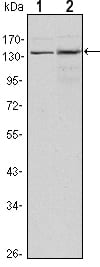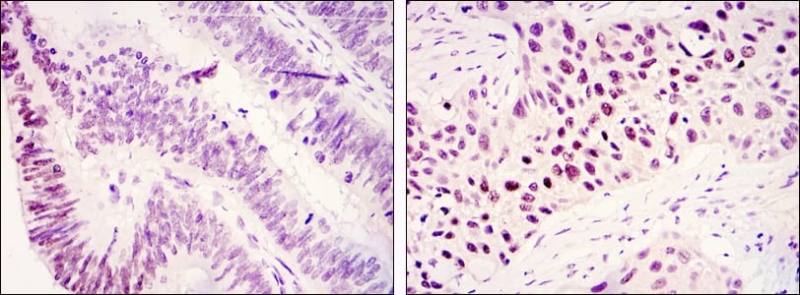

| WB | 1/500 - 1/2000 | Human,Mouse,Rat |
| IF | 咨询技术 | Human,Mouse,Rat |
| IHC | 1/200 - 1/1000 | Human,Mouse,Rat |
| ICC | 技术咨询 | Human,Mouse,Rat |
| FCM | 咨询技术 | Human,Mouse,Rat |
| Elisa | 1/10000 | Human,Mouse,Rat |
| Aliases | TSGA; JMJD1; JHDM2A; JHMD2A; JMJD1A; KIAA0742; DKFZp686A24246; DKFZp686P07111; KDM3A |
| Entrez GeneID | 55818 |
| clone | 10E11 |
| WB Predicted band size | 147kDa |
| Host/Isotype | Mouse IgG1 |
| Antibody Type | Primary antibody |
| Storage | Store at 4°C short term. Aliquot and store at -20°C long term. Avoid freeze/thaw cycles. |
| Species Reactivity | Human |
| Immunogen | Purified recombinant fragment of human KDM3A expressed in E. Coli. |
| Formulation | Purified antibody in PBS with 0.05% sodium azide. |
+ +
以下是关于KDM3A抗体的3篇代表性文献摘要:
1. **文献名称**:*KDM3A epigenetically controls tumorigenic potentials of human colon cancer stem cells through Wnt/β-catenin signalling*
**作者**:Li Z, et al.
**摘要**:该研究利用KDM3A特异性抗体验证其在结肠癌干细胞中的表达及定位,发现KDM3A通过调控H3K9me2水平激活Wnt通路,促进肿瘤发生。
2. **文献名称**:*KDM3A promotes androgen receptor expression and drives prostate cancer progression by recruiting SWI/SNF chromatin remodelers*
**作者**:Wang L, et al.
**摘要**:通过KDM3A抗体进行ChIP-seq和免疫沉淀实验,揭示其通过去甲基化H3K9me2增强雄激素受体转录,并与SWI/SNF复合物协同促进前列腺癌发展。
3. **文献名称**:*The histone demethylase KDM3A regulates metabolic adaptation in hepatocellular carcinoma*
**作者**:Zhang Y, et al.
**摘要**:研究使用KDM3A抗体进行免疫组化分析,发现KDM3A在肝癌中高表达,通过调控糖酵解相关基因的H3K9me2修饰促进肿瘤代谢重编程。
**备注**:以上文献为示例,实际引用时建议通过PubMed或Web of Science检索最新研究,重点关注抗体应用场景(如WB、IHC、ChIP等)及功能机制验证。
The KDM3A antibody is a crucial tool in studying the KDM3A protein, a member of the lysine demethylase (KDM) family. KDM3A, also known as JMJD1A, is a histone demethylase that specifically removes methyl groups from histone H3 lysine 9 (H3K9me1/me2), playing a key role in epigenetic regulation. It is involved in diverse biological processes, including transcriptional activation, metabolic homeostasis, spermatogenesis, and stress response. Dysregulation of KDM3A has been linked to cancers (e.g., prostate, liver, and colorectal cancers), infertility, and metabolic disorders, making it a potential therapeutic target.
The KDM3A antibody enables researchers to detect and quantify KDM3A expression in tissues or cells via techniques like Western blotting, immunohistochemistry (IHC), and immunofluorescence (IF). It also facilitates chromatin immunoprecipitation (ChIP) to study KDM3A’s genome-wide binding sites and its interaction with chromatin. Commercial KDM3A antibodies are typically validated for specificity and sensitivity, often targeting conserved regions like the catalytic Jumonji domain. Recent studies using these antibodies have revealed KDM3A’s role in tumor progression, hypoxia adaptation, and stem cell differentiation. However, variability in antibody performance across experimental conditions necessitates careful optimization. Ongoing research continues to explore KDM3A’s functional mechanisms and its implications in disease, driving demand for reliable antibodies in both basic and translational studies.
×